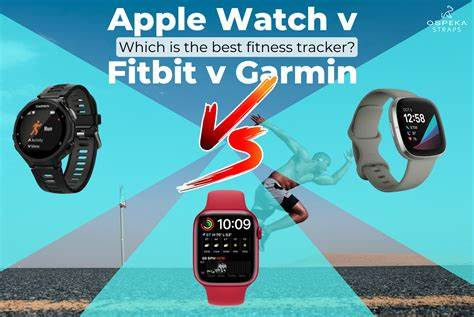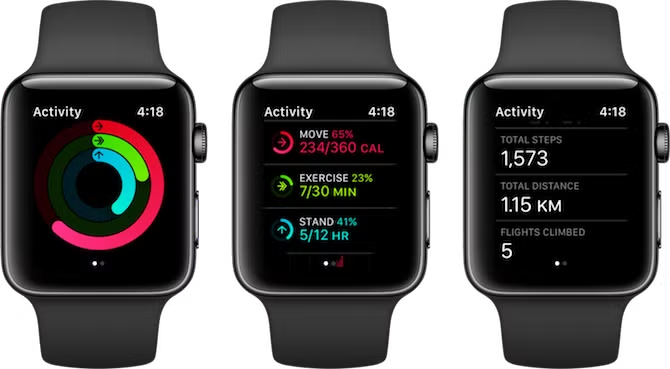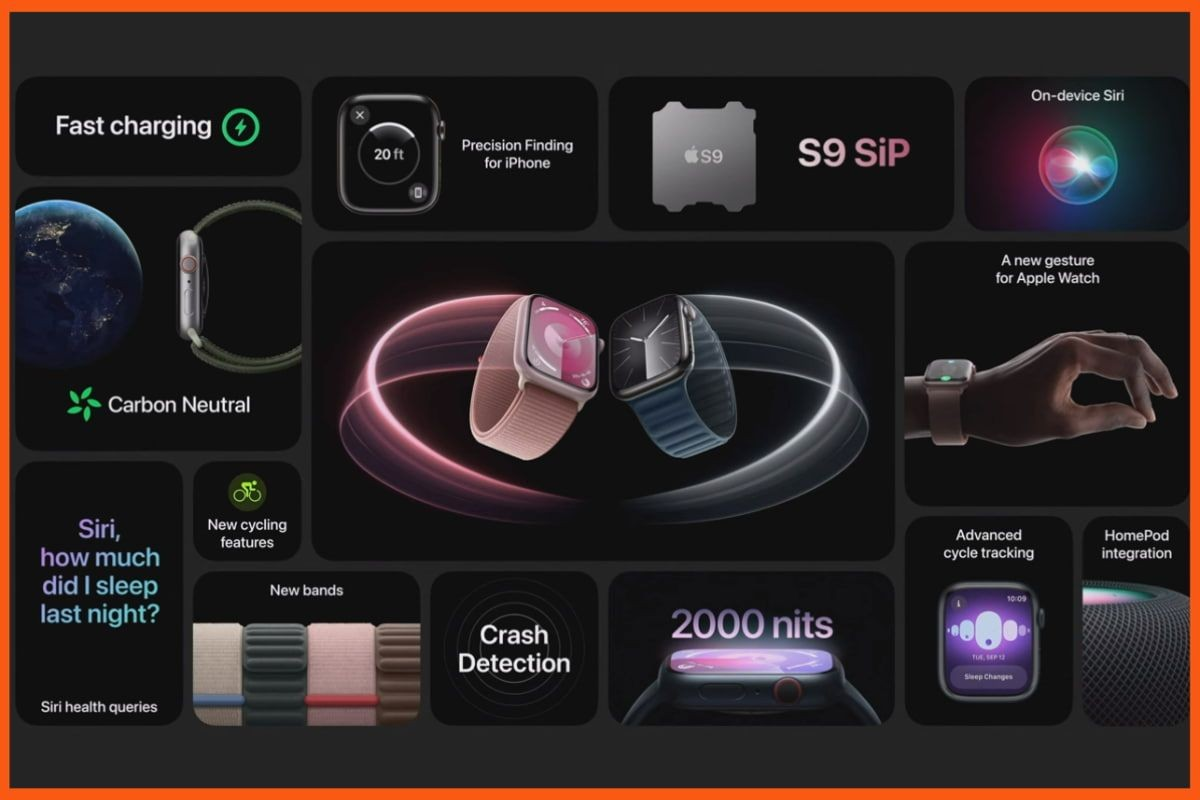Revolutionizing Wearable Tech: The Apple Watch Series 10 Takes Center Stage
Since its revolutionary 2015 launch, the Apple Watch has dominated the wearable technology market, and the most recent model, the Apple Watch Series 10, is setting new standards. The innovative features of this stylish model include advanced health and fitness tracking, a larger, more vivid display, faster charging, and sleep apnoea detection. Features like temperature and water depth sensors, as well as the state-of-the-art watchOS 11, further cement its status as an essential gadget. Both tech enthusiasts and health-conscious consumers are enthralled by Apple's steadfast dedication to innovation and its smooth integration into its ecosystem. More than just a watch, the Apple Watch redefines its function as a necessary companion in contemporary life by being a potent instrument for connectivity, fitness, and health.
Challenges Facing Digital Watches
- Market Saturation: With tech behemoths like Fitbit, Garmin, and Samsung competing for consumers' attention alongside more established watchmakers like Rolex, the digital watch business is extremely competitive. Because of this saturation, it is hard for one brand to stay dominant.
- Battery Life Limitations: Maintaining a long battery life while balancing performance is still quite difficult. Because digital watches have so many features, such as GPS tracking and heart rate monitoring, they fast deplete batteries, forcing manufacturers to come up with creative ways to prolong battery life without compromising performance.
- Reliance on Smartphones: The Apple Watch and many other digital timepieces depend on smartphones to function properly. The convenience of the watch as a stand-alone device is limited by features like alerts, GPS, and certain health tracking that require a paired device.
- Consumer Education: It can be difficult to convince non-techies of the benefits of digital timepieces. Slower adoption may result from many potential users not understanding how these technologies might help daily life or health.
- With the Apple Watch projected to have a 30% global market share in 2023, Apple remains the industry leader in smartwatch technology.
- The Series 8, Ultra, and SE models were the most popular smartwatches sold by Apple in the first nine months of 2023, with 26.7 million sales, contributing to a 7.9% increase in the number of users in the United States.
- Active Users: There are 28.4 million Apple Watch owners in the United States alone, and 80% of iPhone users will own one by 2024.
- Engagement: Apple Watch customers exhibit significant user engagement, checking their gadgets over 80 times a day.
- Apple's high customer satisfaction rating is a result of its cutting-edge health features, such as blood oxygen monitoring and ECG.
Features:
- Apple Watch: Sets the standard for cutting-edge health features like blood oxygen, heart rate, fitness, GPS, ECG, fall detection, and sleep monitoring.
- Fitbit: Excellent in tracking heart rate and steps, but it lacks the sophisticated health features that Apple provides.
- Although it has blood pressure and ECG monitoring, the Samsung Galaxy Watch does not have Apple's smooth ecosystem integration.
- Although it lacks the Apple Watch's extensive health capabilities, Garmin is perfect for athletes who need metrics relevant to their sport.
Ecosystem:
- Apple Watch: Enhances convenience with features like Apple Pay and notifications and seamlessly connects with iPhone, iPad, Mac, and more.
- Despite being compatible with both iOS and Android, Fitbit does not offer the smooth, networked experience of Apple's ecosystem.
- Though not as seamless as Apple's, the Samsung Galaxy Watch integrates seamlessly with Samsung smartphones.
- Garmin: With a focus on fitness applications and respectable cross-platform compatibility, this company lacks ecosystem integration on par with Apple.
Design and Branding:
- Apple Watch: Stylish, upscale, and customisable, it appeals as a fashion statement as well as a technological gadget.
- Fitbit: Usable, reasonably priced, and designed with fitness enthusiasts in mind.
- Samsung Galaxy Watch: a high-end, somewhat customisable, but more conventionally styled device.
- Garmin: Stylish, functional, and built to last, this brand caters to fitness and outdoor aficionados.
- Innovation: With its innovative features like blood oxygen monitoring, fall detection, and ECG monitoring, the Apple Watch completely changed wearable technology. Users may access real-time health insights with these advancements, and they can stay connected without using their phone thanks to seamless notifications. By providing individualised training routines, apps such as Fitness+ increase the accessibility and appeal of fitness.
- Lifestyle Integration: The Apple Watch is more than just a digital timepiece; it's a fashion accessory with interchangeable bands and faces to suit any style. It is a fitness gadget that encourages users to stay active by tracking steps, exercises, and activity rings. It combines elegance and utility to become a fashion statement, health monitor, and personal assistant.
- Trust: Apple has gained users' trust by prioritising data privacy and making sure that medical records are safe and encrypted. Features like fall detection and ECG offer trustworthy health information, enhancing the Apple Watch's already stellar reputation for security and quality.
- Lock-in to the ecosystem: Apple's smooth device integration produces a cohesive experience. The Apple Watch's features, such as Handoff, Continuity, and iCloud sync, improve user convenience by seamlessly integrating with the iPhone, iPad, Mac, and AirPods. This degree of integration is unmatched by rivals, making it challenging for them to provide an experience that is as seamless.
- Apple's reputation for quality and innovation fosters premium loyalty, which in turn creates brand equity. Because of their standing as status symbols, its products like the Apple Watch have a deep emotional bond with their customers. Developed over many years, this brand power is difficult for rivals to match because it encompasses not only product excellence but also customer experience and cultural influence.
- Innovation is fuelled by Apple's significant investment in research and development, which allows the business to produce unique technologies like the S-series CPUs and cutting-edge health sensors. Due to the fact that smaller competitors use off-the-shelf components and are unable to match Apple's level of performance and optimisation, the company has a clear advantage.
- Digital watch companies can prosper by focusing on under-represented segments, such as outdoor enthusiasts, by offering tough designs and specialised monitoring for pursuits like hiking. Furthermore, appealing to consumers on a tight budget by offering feature-rich, reasonably priced devices can draw in customers unable to purchase high-end products like the Apple Watch.
- Longer battery life is a key differentiator in battery innovations. By implementing innovations such as solar charging and low-power modes, brands can concentrate on increasing battery efficiency and prolonging battery life. Apple's daily charging requirement can be challenged by watches with a battery life of several weeks.
- Digital watches can reach a larger audience by providing cross-platform connectivity with both iOS and Android handsets. Integrating with different third-party apps and health systems allows organisations to offer flexibility and improve the user experience in general.
- Health-Centric Features: The Apple Watch has features that prioritise health, such as exercise tracking to encourage users with customised objectives, blood oxygen monitoring for respiratory health, and ECG monitoring to detect heart rhythms. Trust is built by these health products, particularly for individuals who have fitness goals or health issues.
- Regular Software Updates: Apple provides new features and security enhancements to keep older models current with software updates. Apple keeps its products current by incorporating user feedback, which gives consumers value over time and fosters brand loyalty.
- Excellent Experience: With their well-informed employees and individualised assistance, Apple provides an excellent in-store experience. Trust is strengthened with AppleCare+ and first-rate customer support, and the Apple Watch is solidified as more than simply a product—it's a component of a seamless, high-end lifestyle—with easily available repairs providing peace of mind.
1.Garmin vs. Apple: While the Apple Watch requires daily charging because of its high-performance capabilities, Garmin excels with a battery life that lasts up to weeks, making it perfect for outdoor enthusiasts.
- For athletes and explorers, Garmin's durable designs and cutting-edge outdoor equipment, such as GPS and topographic maps, are ideal.
- Brand Appeal: Garmin is well-respected in the outdoor market but does not have the same well-known brand as Apple, which is dominated by svelte designs and lifestyle appeal.
2.Samsung vs. Apple: With features like blood pressure monitoring and ECG, Samsung provides fierce competition, mirroring Apple's tech-driven strategy.
- Ecosystem: Samsung finds it difficult to replicate Apple's unified user experience due to its smooth device integration across iPhone, iPad, and Mac.
- Customer Experience: Apple clearly outperforms Samsung thanks to its integrated ecosystem, which boosts customer satisfaction and fosters loyalty.
3.Apple vs. Fitbit: Fitbit caters to customers looking for inexpensive fitness trackers that don't break the bank by providing basic health tracking.
- Apple distinguishes itself with its high-end design and cutting-edge health measures, like blood oxygen monitoring and ECG, which Fitbit does not have.
- Market Position: Fitbit focuses on fitness, while Apple gives the Watch a wider appeal by framing it as a multifunctional gadget that combines exercise, health, and style.
- Innovations in Health Features: Leading the way in the introduction of medical-grade health tools such as blood oxygen monitoring, fall detection, and ECG monitoring was the Apple Watch. These developments distinguish Apple and make it desirable to people who value general wellness as well as exercise aficionados.
- Interaction of Ecosystems: The iPhone, iPad, and Mac are all seamlessly integrated into Apple's ecosystem, providing a cohesive experience. Because Handoff and iCloud sync make it easy for users to switch between devices, Apple's networked platform is difficult for rivals to match.
- Design Leadership: The Apple Watch distinguishes itself by fusing style and functionality with its elegant design, high-quality materials, and customisable features. It offers something for everyone, appealing to a broad spectrum of people from tech enthusiasts to those who are fashion-forward.
Competitors and New Dangers Brands like Samsung, Fitbit, Garmin, and Amazfit are becoming more and more competitive with Apple's hegemony in the smartwatch market. Particularly in the areas of connectivity and health tracking, these companies are attracting customers with their cutting-edge capabilities, affordable prices, and fashionable designs. To further diversify the market, new players like Longlive, LutiBand, and WatchOut Wearables are also investigating novel solutions, including personal safety gadgets and chronic illness management.
The Effect of Government Regulations on Growth Policies from the government, such as India's National Medical Devices Policy, 2023, may have an impact on how health-related features are developed for the Apple Watch and other devices. Different countries have different laws governing ECG functionality; in some, features cannot be supplied until approval has been obtained.
Key Lessons from Apple’s Digital Watch Success
- Customer-Centric Innovation: Apple prioritises addressing actual user issues, such as health monitoring with products like blood oxygen monitoring, fall detection, and ECG. Not simply technological advancements, but user requirements are the foundation of these inventions. Apple also pays attention to customer feedback, which guarantees ongoing product development.
- Ecosystem Integration: By integrating with other Apple products in a seamless manner, the Apple Watch offers a consistent user experience. Convenient features that retain users in the Apple ecosystem include the ability to utilise Apple Pay straight from the wrist or receive calls and messages.
- Apple strategically markets their watch as a fashionable adornment as well as a useful technological tool. The watch is a lifestyle product because of its premium features and customisable designs, and its high brand recognition furthers its appeal and elegance.
- Apple Watch Health Features: Apple - Healthcare
- Apple Watch Sensors: MyHealthyApple - Sensors on Apple Watch
- Wearable Tech Regulations: Wareable - Wearable Tech and Regulation
















Comments
Post a Comment